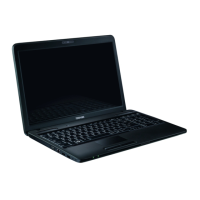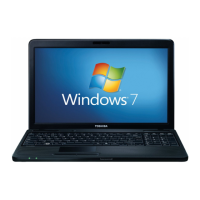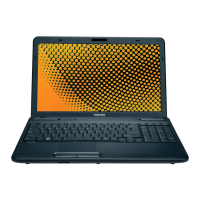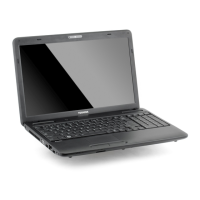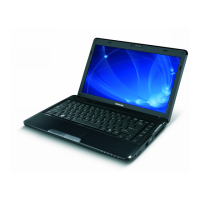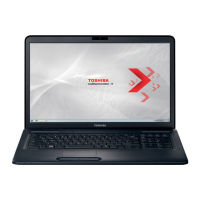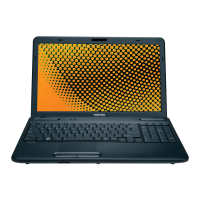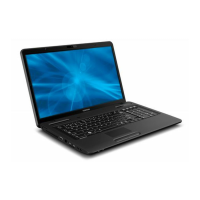Do you have a question about the Toshiba Satellite C665 and is the answer not in the manual?
Describes computer hardware components like CPU, memory, and storage.
Details pre-installed software utilities for system management and customization.
Information on expanding computer capabilities with optional hardware and accessories.
Instructions on launching and navigating the TOSHIBA HW Setup program for system configuration.
Customizing display, boot priority, keyboard, SATA, LAN, and USB settings via BIOS.
Guidelines for environmentally sound disposal of computer hardware and batteries.
Information on the EU chemical regulation REACH and Toshiba's commitment.
Explanation of formatting, icons, and key notations used throughout the manual.
Defines graphical icons and keyboard key representations for user guidance.
Describes different message classifications like warning, caution, and notes.
Ensures proper airflow for the computer and AC adaptor to prevent overheating.
Tips for setting up a safe workspace to protect the computer from environmental factors.
Guidelines to avoid physical strain and burns from prolonged computer use.
Warnings against physical damage and interference from mobile phones.
Lists essential hardware and documentation items to verify upon receiving the computer.
Covers connecting AC adaptor, opening display, turning power on/off, and initial startup.
Step-by-step guide on how to connect the AC adaptor for charging and powering the computer.
Instructions on how to open the display panel safely to the desired viewing angle.
Procedure for powering on the computer and initial startup for the operating system.
Methods for shutting down or sleeping the computer, including Shut Down and Sleep Modes.
Explanation of Sleep and Hibernation modes for power saving and resuming work.
Steps to create backup media (DVD or USB) for system recovery purposes.
Procedure to restore pre-installed software from the hidden recovery partition on the hard drive.
Instructions for restoring the system using previously created recovery media.
Identification of key external components of the computer when the display is closed.
Details ports and features located on the left side of the computer.
Details ports and features located on the right side of the computer.
Identifies ports and features on the back of the computer.
Locates battery lock, memory slot, and cooling vents on the computer's underside.
Identifies components visible when the display panel is open, including webcam and keyboard.
Describes the function of CAPS LOCK and NUM LOCK status indicators on the keyboard.
Information about the computer's CPU, its specifications, and performance factors.
Details on memory slots, capacity, and Video RAM usage.
Information on HDD/SSD capacity, types, and storage considerations.
Details on the display panel resolution, colors, and the Display Power Saving Technology feature.
Explanation of AMD Vari-Bright for optimizing LCD contrast and power consumption.
Information on built-in Ethernet LAN support, speeds, and cable requirements.
Details on Bluetooth and Wireless LAN capabilities and their features.
Describes utilities like Power Saver, PC Diagnostic Tool, and HW Setup for system management.
Explains utilities for Face Recognition, DVD playback, Assist, and Disc Creator.
Details on using the bridge media slot for various memory card types.
Instructions for installing and removing additional memory modules to upgrade system memory.
Details on optional accessories like memory kits and universal AC adaptors.
Information on purchasing and using additional battery packs for extended use.
Guide to operating the Touch Pad for cursor control, clicks, and drag-and-drop actions.
Instructions for operating the built-in web camera for video recording and communication.
Steps for registering and using face recognition for Windows login security.
Instructions for loading and viewing discs using the DVD Super Multi drive.
Guide to using TOSHIBA Disc Creator for writing data to CD and DVD media.
Instructions for adjusting system volume, microphone levels, and changing system sounds.
Recommendations for enabling encryption and security features for wireless connections.
Information on Bluetooth features, worldwide operation, radio links, and security mechanisms.
Instructions for safely cleaning the computer's exterior and display screen.
Precautions to take when moving the computer to prevent damage or injury.
Overview of the keyboard layout, including typewriter, function, and special keys.
Explanation of F1-F9 function keys and FN key combinations for specific features.
Description of keys like the Windows Start Button and Application key for system navigation.
Explanation of power states, battery charge levels, and corresponding LED indicators.
Information on battery packs, their types, and basic handling precautions.
Step-by-step instructions for safely removing and installing the computer's battery pack.
Guide to setting, changing, or deleting user passwords for system login security.
Information on setting supervisor passwords and logging in with user passwords.
Instructions on launching the HW Setup program and understanding its interface and buttons.
Detailed steps for setting, deleting, or managing user passwords in the BIOS.
Configuring display settings for startup and setting the boot device priority.
Adjusting system boot speed and enabling/disabling Wake-up on Keyboard feature.
Configuring SATA interface performance and LAN features like Wake-up on LAN.
Enabling or disabling USB Legacy Emulation for compatibility with older USB devices.
Guidelines and strategies for identifying and resolving computer problems effectively.
Basic checks for common issues like peripheral connection and device configuration.
Questions to ask and observations to make when diagnosing hardware or software malfunctions.
Checks for common problems related to system start-up, hardware components, and peripherals.
Troubleshooting self-test failures and power-related problems, including overheating.
Steps to resolve issues when the AC adaptor is not powering the computer correctly.
Diagnosing problems related to the battery not powering or charging the computer.
Resolving problems with lost system date/time settings due to RTC battery issues.
Guidance for resolving issues with keyboard output or functionality.
Resolving display issues like 'No display' or markings on the screen.
Steps to resolve problems like the computer not booting from the hard disk drive.
Resolving issues with accessing CDs/DVDs or incorrect disc playback.
Resolving errors, write protection issues, or read errors with memory cards.
Troubleshooting Touch Pad response, double-tapping, and pointer speed settings.
Resolving issues with USB devices not working or driver installation problems.
Resolving errors related to memory module installation in the wrong slots.
Resolving issues with no sound, annoying sounds, or volume adjustment problems.
Resolving issues with external monitors not turning on, displaying, or showing errors.
Troubleshooting LAN access, Wake-up on LAN, Wireless LAN, and Bluetooth connectivity.
Resolving issues when the Recovery Media Creator cannot launch due to missing recovery partitions.
Guidance on seeking additional technical assistance from TOSHIBA or resellers.
Details the physical size and weight specifications of the computer.
Specifies operating and non-operating conditions for temperature, humidity, and altitude.
Lists the voltage and frequency requirements for the AC adaptor and computer.
Explains how the display controller interprets commands and manages screen resolution and colors.
Instructions for configuring screen resolution and adjusting display settings for optimal viewing.
Details Wireless LAN compatibility standards and Wi-Fi certification.
Information on Bluetooth compatibility standards and features.
Lists radio approvals and restrictions for specific wireless network adapters in various countries.
Details required specifications for AC power cords, including length, wire size, and ratings.
Lists the certification agencies and standards for AC power cords in different regions.
Explains factors that may affect CPU performance and conditions for automatic shutdown.
Information on 64-bit computing requirements and main system memory usage.
Details on factors affecting battery life and definitions of HDD capacity measurements.
Information on LCD screen brightness deterioration and GPU performance variations.
Details on Wireless LAN transmission speed and copy protection standards for media.
Definitions of common acronyms and abbreviations used throughout the user manual.
| RAM | 2GB DDR3 |
|---|---|
| Storage | 320GB HDD |
| Graphics | Intel HD Graphics |
| Operating System | Windows 7 Home Basic |
| Battery | 6-cell Lithium-ion |
| Optical Drive | DVD SuperMulti |
| LAN | 10/100 Ethernet |
| USB Ports | 2 x USB 2.0 |
| Webcam | Integrated Webcam |
| Bluetooth | No |
| Display | 15.6-inch HD |
| Weight | 2.3 kg |
| Hard Drive | 320GB |
| Wireless | 802.11b/g/n |
| Ports | VGA, HDMI |

